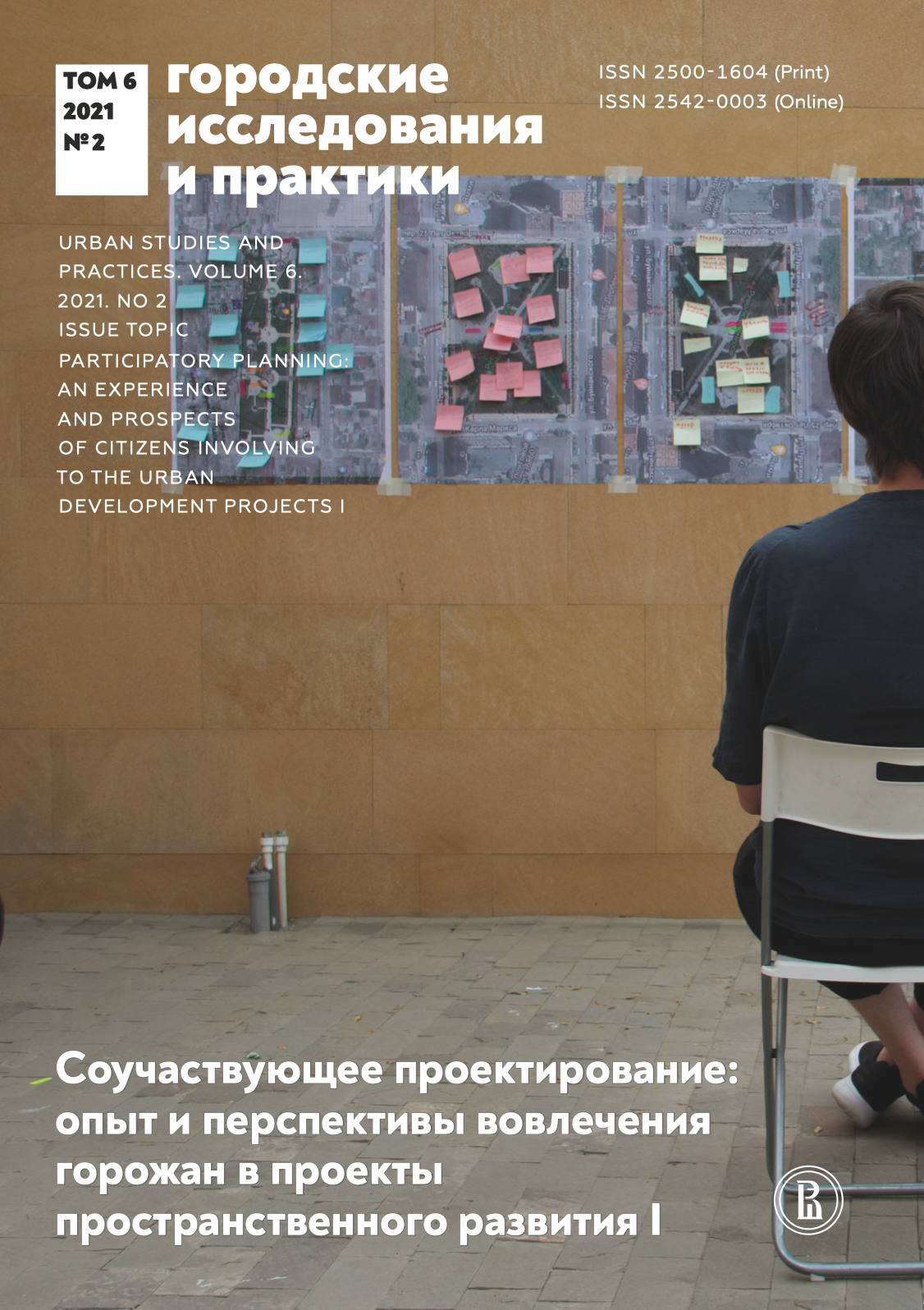Соучаствующее проектирование: особенности подхода в России
Аннотация
Статья посвящена исследованию особенностей подхода в российских практиках соучаствующего проектирования. Автор опирается на серию интервью с ключевыми экспертами, занимающимися соучаствующим проектированием в России. На основе анализа этих интервью сделаны выводы о том, из чего состоит понятие «соучаствующее проектирование» и что в это понятие вкладывают те, кто им занимается. Развернувшаяся заочная дискуссия демонстрирует схожие взгляды и противоречия, сложность и многомерность, которая скрывается за этим явлением и процессом. Автор дает ответ на вопрос, почему соучаствующее проектирование, являясь, по сути, универсальным инструментом, используется в подавляющем числе случаев именно в благоустройстве и не используется, например, в образовании или других сферах, где точка зрения конечного пользователя не менее важна. Обсуждается отличие соучаствующего проектирования от манипуляции и имитации. Проанализированы причины оторванности практик соучаствующего проектирования от местного самоуправления. Определено, что такое продукт и результат соучаствующего проектирования, каковы его эффекты, а также как устроена его сфера.
Скачивания
Литература
Атлас успешных практик соучастия и вовлечения жителей в развитие городской среды (2020) Режим доступа: https://100gorodov.ru/attachments/1/15/dc2632c1ad40629085abdde566b9ae/Atlas_100_print.pdf (дата обращения: 24.08.2020).
База знаний // Проектная группа В. Режим доступа: http://barchitects.com/mora (дата обращения: 24.08.2020).
Глазычев В.Л. (1995) Городская среда. Технология развития: настольная книга. М.: Ладья.
Глазычев В.Л. (2010) Избранные лекции по муниципальной политике. Режим доступа: http://www.glazychev.ru/courses/mp/mp_04.htm (дата обращения: 24.08.2020).
Глазычев В.Л. (2011) Развитие местных сообществ. Как возродить социальный оптимизм? Режим доступа: http://www.glazychev.ru/courses/2011_lecture_razvitie_mestnyh_soobschestv.htm (дата обращения: 24.08.2020).
Кияненко К.В. (2010) Генри Санофф: к архитектуре, озабоченной человеком, о проектировании с людьми, для людей // Архитектурный вестник. № 1. С. 96–101.
Кияненко К.В. (2017) Социальные стратегии архитектурного программирования // Innovative Project. Т. 2. № 2. С. 54–68.
Кияненко К.В. (2018) Парадигмы социального знания и обоснования в архитектуре // Социологические исследования. Т. 9. № 9. С. 30–39.
Лаборатория городской среды. Вологда. Режим доступа: https://vk.com/vologda.sreda (дата обращения: 24.08.2020).
Ледяев В.Г. (2012) Социология власти. Теория и опыт эмпирического исследования власти в городских сообществах. М.: Национальный исследовательский университет «Высшая школа экономики».
Медведев И.Р. (2017) Разрешение городских конфликтов. М.: Infotropic Media.
Методика оценки заявки на участие во Всероссийском конкурсе лучших проектов создания комфортной городской среды (2020) Режим доступа: https://files.gorodsreda.ru/upload/landing/Utverzhdenaya-Metodika_Prilozhenie-2.pdf (дата обращения: 24.08.2020).
Национальный проект «Жилье и городская среда». Режим доступа: https://futurerussia.gov.ru/zhile-i-gorodskaya-sreda (дата обращения: 24.08.2020).
Об общих принципах организации местного самоуправления в Российской Федерации (2003) Федеральный закон от 06.10.2003 N 131-ФЗ (ред. от 01.07.2021) // Российская газета. 2003. 8 октября.
Организация и проведение общественных обсуждений проектов развития территорий (2018) Методические рекомендации. Режим доступа: https://urban.zapovednik.ru/specialnaya-literatura/rabota-s-soobshchestvami-i-souchastvuyuschee-proektirovanie/organizatsiya-i-provedenie-obschestvennyh-obsuzhdeniy-proektov-razvitiya-territoriy/ (дата обращения: 10.05.2020).
Санофф Г. (2015) Соучаствующее проектирование. Практики общественного участия в формировании среды больших и малых городов. Вологда: Проектная группа 8.
Снигирева Н. (2017) Рекомендации Министерства строительства и жилищно-коммунального хозяйства Российской Федерации по организации общественного участия в реализации проектов комплексного благоустройства городской среды. М.: Минстрой России.
Снигирева Н.В. (2014) Соучаствующее проектирование обновляет город // Государственная служба. № 4 (90)
Создай свой город (2018) Методическое пособие по развитию дворов и общественных пространств в малых городах. Режим доступа: https://omk.ru/press/sozday_svoy_gorod.pdf (дата обращения: 10.05.2020).
Стандарт вовлечения граждан в решение вопросов развития городской среды (2020) М.: Центр городских компетенций Агентства стратегических инициатив совместно с Министерством строительства и жилищно-коммунального хозяйства РФ. С. 131
Чирикова А.Е., Ледяев В.Г. (2017) Власть в малом российском городе. М.: Национальный исследовательский университет «Высшая школа экономики».
Чирикова А.Е., Ледяев В.Г., Ледяева О.М. (2015) Муниципальная реформа и распределение власти в руководстве малого российского города // Вестник Тамбовского университета. Серия: Гуманитарные науки. № 4 (144).
Arnstein S.R. (1969) A Ladder of Citizen Participation // Journal of the American Institute of Planners. Vol. 35. No. 4. P. 216–224.

